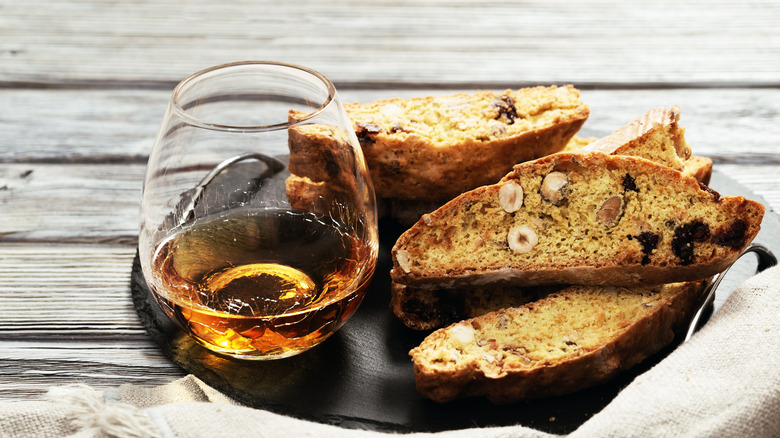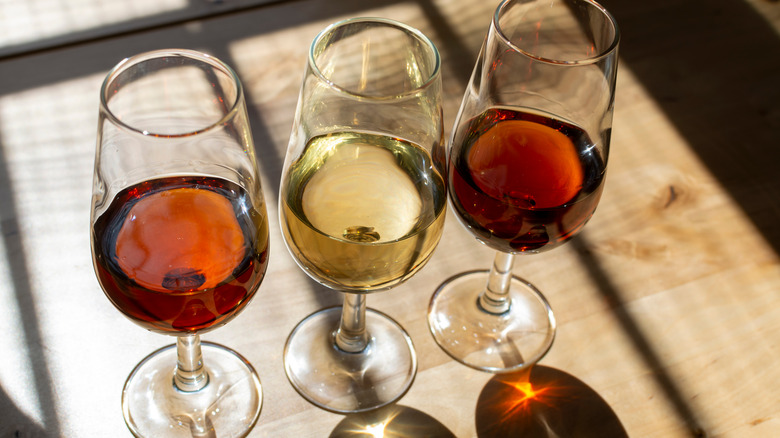When To Pair A Dessert With Wine (And When To Leave It Alone)
Learning more about the world of fine dining, or hosting means that you've likely come across phrases like "this steak pairs well with a malbec", or some other combination of food and wine. While it may sound strange at first to think of your dinner and drink order as a package deal there is a reason for doing so.
Wine has been paired with foods for centuries as it was the safest drink available in many early civilizations. Certain wines and foods became linked together by these cultures as it was discovered that they enhanced each other's flavors. A wine's acidity is partly responsible for this. It tends to create a response from the salivary glands which heightens our perceptions of flavors.
To create the best dining experience with wine it usually helps to consider a few key ideas. It can help to decide whether you want to complement or contrast flavors when considering a pairing. While some wines can boost a dish with similar tasting notes or aromas, others might add more by introducing new elements to your palette. A wine pairing can also help tell the story of a city or region. Certain pairings go way back, and local wines and foods are often unique expressions of a place.
Of course, the fun doesn't have to stop once the main course is cleared away. Pairing wine with desserts can add just as much to any dining experience.
What to consider when pairing wines with dessert
Just like any other wine pairing, pairing a dessert with the right wine opens you up to a world of possibilities. Thankfully, that means that whatever you dream up, you can do (as long as you're prepared). If you want to pair the cake with champagne, then go for it!
Pairing a wine with a dessert is similar to pairing it with a meal. The main difference is that you need to consider sweetness levels more than anything else. Pairing a super sweet dessert with an average wine can actually make the wine taste bitter by comparison. Because of this, you'll want to make sure that whatever wine you choose is at least close in sweetness to your dessert, if not sweeter. If you're throwing a pairing together at the last second though, and don't have something sweeter than your dessert on hand you'll be better off going without the pairing than bringing out a bottle that will end up tasting bitter.
You'll also want there to be a balance between the richness of the dessert and the wine. Looking into dessert wines opens the door to strongly fortified wines like port, sherry, and Madeira. These strongly flavored wines will overpower something light even if the sugar content is similar. This works both ways as well. The richness will wash out the wine instead of working with it, and you'll be wishing you served them separately.
Different kinds of dessert wines
Not all dessert wines are sweet. There are also plenty of dry and semi-dry wines that can work well in a dessert pairing as well. A dry riesling or sauvignon blanc, for example, can cut through syrupy desserts or add notes of fruit to something creamy.
When it comes to sweeter wines it's important to distinguish what makes them sweet. A wine usually tastes sweeter thanks to the sugars that are left over after fermentation. Some winemakers achieve this by ending fermentation early on, while others leave the grapes on the vine for an extended period to allow the sugars to concentrate more deeply before being turned to wine.
There's a lot more to understanding dessert wines than just sweet and dry, however. Wine Folly chooses to classify dessert wines into five categories: lightly sweet, sparkling, richly sweet, sweet red, and fortified. It may take some time to understand what falls into these categories and what each of them pairs best with, but once they're understood it will make pairing your dessert with the right wine a fun and exciting adventure.


